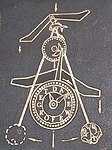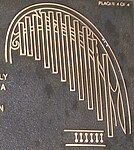Hornsby Water Clock
The Hornsby Water Clock is a kinetic sculpture , decorative fountain and functional clock located on the Florence Street Pedestrian Mall in Hornsby , New South Wales , Australia . The sculpture is also entitled Man, Time and the Environment . It was unveiled in 1993. The sculpture was designed by Victor Cusack and made from components made of bronze , stainless steel and glass by Victor and his foundry floor manager Rex Feakes . The production, including the necessary changes in the mall, cost more than A $ 1 million. and lasted two and a half years; As a result, chicken bones and other debris caused several serious damage before the filtration of the water was improved.
Total work of art
The clock is a combination of three water clocks - a Klepsydra , the Greek water clocks from the 4th century BC. C. is modeled; a water wheel clock based on a Chinese clock from the 11th century and a Swiss pendulum clock from the 17th century - it also has a 17-tone bronze carillon , which shows the hours based on a 250-year-old model beats in an English church. The entire installation is mounted on a floating pontoon , which rotates every 12 hours and thus provides a fourth time indicator, as a pointer slides along Roman numbers that are arranged in the water in the pool around the fountain.
The sculpture is approx. 8 m high and weighs 20 t.
Embassy
The clock is explained by four plaques attached to the fountain. The functionality of the three different clocks is explained on three of them and the message of the sculpture is pointed out on one of the plaques.
The message of the watch indicates that Hornsby is an area that still has extensive untouched natural treasures and contrasts this with the joyful creativity of people who destroy this nature more and more because they are unable to coexist. The clock thus points out the polarity between creativity and destruction, honors the beauty of the environment and calls for responsibility towards “animal companions (human and others)”.
This is why the sculpture shows a number of animals: owls Schwalm (Tawny frogmouth) Rainbow Lorikeet (Rainbow lorikeet), Australian Pied Cormorant (Pied cormorant), Little Penguin (Little penguin), Australian Pelican (Australian pelican), water dragons (Water dragon), blue-tongued skink ( Blue-tongued skink), Goanna (monitor lizard), gray-headed flying fox (gray-headed flying fox), possum (Common brushtail possum), white-bellied sea eagle (White-bellied sea eagle), man
The individual clocks
Greek Clepsydra
In the Klepsydra, water flows into a fixed vessel from a tank, which is always kept meniscus-full (to overflow) so that excess water can drain off. The water depth in the tank remains constant and the water that runs off into the second vessel becomes a measure of time. In Hornsby, two pipes are moveable so that they tip over and drain the water into the well basin as soon as they are full. Then they return to the starting position due to their counterweights. The counterweights are shaped like a mutton's head , while the tubes are decorated with the head of a hermaphrodite .
Chinese water wheel clock
The water wheel clock uses 20 buckets attached to a wheel. The wheel is 2.3 m in diameter. Water from an overflow tank flows into a bucket until the weight of the water moves the wheel. The counterweight in this case is a Buddha sculpture. When it falls, the bucket triggers a mechanism that frees the wheel and lets it turn. Then the mechanism engages again and the next bucket fills up.
The construction is based on a model by Su Song , who constructed a clock for his observatory around 1088-1092.
Swiss pendulum clock
It is said to be the largest water-powered pendulum clock ever built. It uses the same 4-second pendulum cycle as the Great Clock of Westminster (Big Ben). The weight of the pendulum is 350 kg. The construction is based on a clock designed by Claude Perrault in 1669, but never built.
The 5 m large pendulum is mounted on a 'knife-edge' to minimize friction and is driven by the 'top drive' (the upper movable glass chutes); as soon as one side is full, it drives the mechanism so that the water flows out and the second tank receives the water supply underneath the eagle sculpture.
Seconds are marked by turning the glass wheel, which has 30 markings on the edge. Each half cycle of the pendulum (2 sec) moves the wheel to the next marking so that it rotates once on its own axis every minute. A cam on the second wheel opens the bolt on the lower wheel every 30 seconds, whereby 100 liters of water are poured out and the minute hand is moved once and the hour hand once every 12 minutes.
Instead of numbers, the hour markers on the dial are made up of letters that form the sentence “Dare we forget”. The clock is adorned with various animals and depictions of Aboriginal art to remind people that life forms are lost because we are not careful with the land, and that Hornsby used to be home to a large tribal population who suffered the same fate how many species of animals.
The pendulum clock is also used to drive the rotating pontoon, the carillon and the water supply for the Chinese clock.
Pontoon Rotation Clock (pontoon clock)
The entire sculpture rotates clockwise in the water of the fountain basin. The speed of rotation is controlled by a locking mechanism on the edge of the pontoon. The mechanism locks into 60 brackets that are attached to the wall of the pool. Every 12 minutes the lock is released by a mechanism that drives the pendulum clock and the pontoon rotates until the next stop
Carillon (carillon)
The Carillon has 17 bells cast bells -Bronze that automatically sound the hour, but can also be played manually. The mechanism is based on a design created by Harringtons of Coventry and used in a church on Haywards Heath in Sussex . In contrast to the original, the frame is made of metal and the carillon has 17 instead of 9 bells. Together the bells weigh about 1 ton and have the range of the octave above Middle C plus 3 tones above and the G below.
gallery
Individual evidence
- ↑ The clock in historyofsydney.com .
- ↑ abc.net: damage to the clock.
- ↑ Description according to the photos of the explanatory badges.
- ↑ Text of the plaque: “This mobile water sculpture is a unique environmental statement, particularly relevant to Hornsby, an area retaining extensive unspoilt natural areas with abundant land and marine based flora and fauna. Its symbolism is contrasting man's historically joyful creativity with his rapidly increasing inability to co-exist with virtually all forms of life on earth. "
- ↑ there is a "polarity" between the "joyful complexity of creation" shown in the mechanisms mankind has invented such as those on display and the destruction we are causing by the rapidly rising global population. It pays "tribute" to the beauty of the environment in the area and our need to be responsible to our "fellow animals (human and otherwise)".
- ↑ undoubtedly the largest water-driven pendulum clock ever built.
- ↑ remind us that we are losing species on our earth due to our sometimes insensitive land use [...] as a reminder that Hornsby once maintained a strong tribal population that suffered the same fate as many animals are suffering.
Web links
- The artworks of Victor Cusack - artist, sculptor, author, poet (Victor's website); Pictures: [1] , [2] .
- dailytelegraph.com.au
Coordinates: 33 ° 42 ′ 14.4 ″ S , 151 ° 6 ′ 2.1 ″ E













